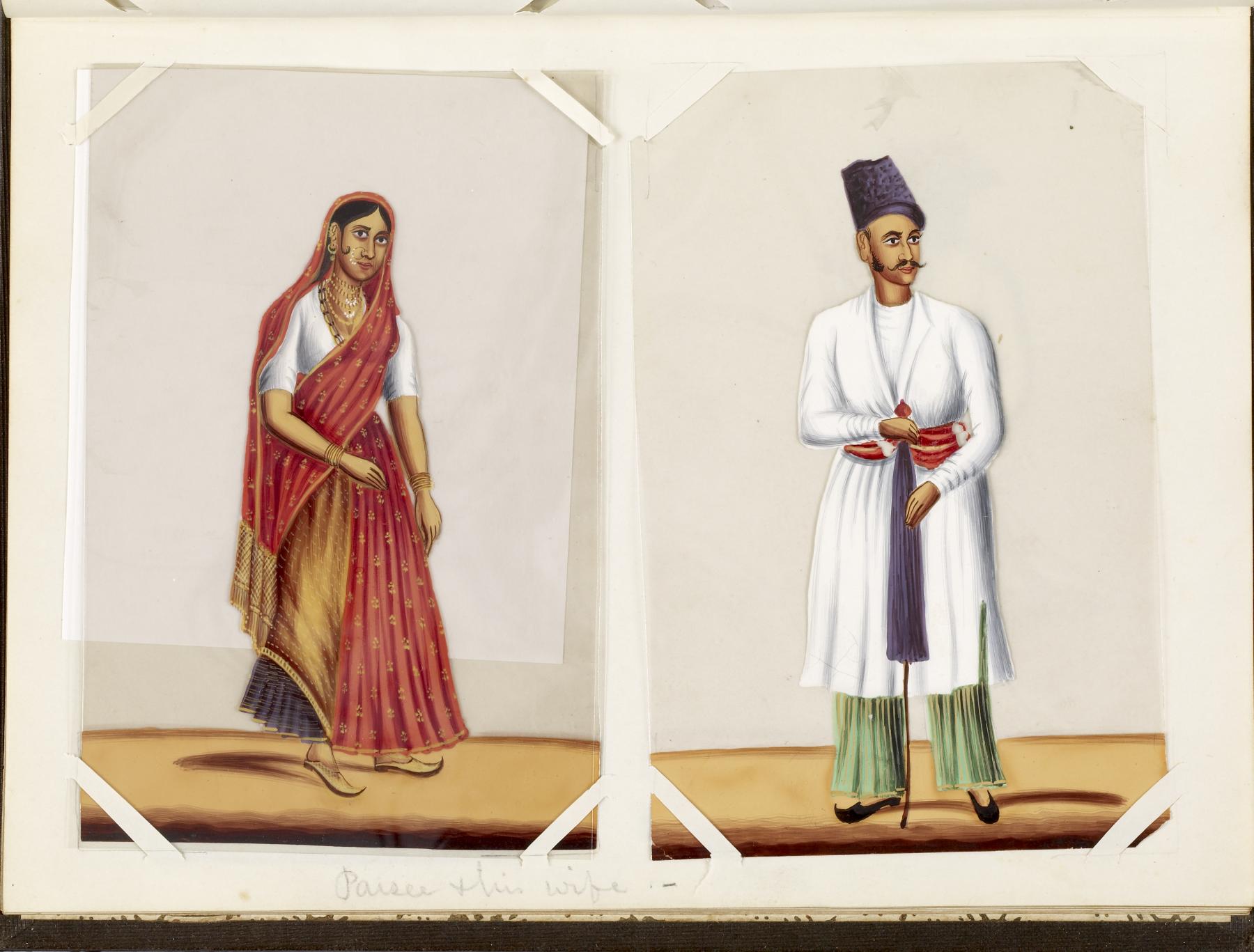|
Navjote
The Navjote (, ''sedreh-pushi'') ceremony is the ritual through which an individual is inducted into the Zoroastrianism, Zoroastrian religion and begins to wear the sedreh and kushti. The term ''navjote'' is used primarily by the Zoroastrians of India (the Parsis), while ''sedreh pushi'' is used primarily by the Zoroastrians of Iran. The word 'navjote' is a Latinized form of the Gujarati language#Dialects, Parsi Gujarati compound of ''nav'' "new" and ''jote'' "reciter [of prayer]", "invoker", "sacrificer". The second half of the word is—via Zoroastrian Middle Persian ''zot''—an indirect continuation of Avestan ''zaotar'', with /z/ eventually becoming /j/ because /z/ is not Phoneme , phonemic in Gujarati. The Persian term ''sedreh pushi'' translates to "Putting on the sedreh," a reference to the main component of the ritual. Age Although there is no upper limit to the age of the individual for which the ceremony takes place, in common practice it occurs before a gir ... [...More Info...] [...Related Items...] OR: [Wikipedia] [Google] [Baidu] |
Parsi
The Parsis or Parsees () are a Zoroastrian ethnic group in the Indian subcontinent. They are descended from Persian refugees who migrated to the Indian subcontinent during and after the Arab-Islamic conquest of Iran in the 7th century, when Zoroastrians were persecuted by the early Muslims. Representing the elder of the Indian subcontinent's two Zoroastrian communities, the Parsi people are culturally, linguistically, and socially distinct from the Iranis, whose Zoroastrian ancestors migrated to British-ruled India from Qajar-era Iran. The word ''Parsi'' is derived from the Persian language, and literally translates to ''Persian'' ().Parsee, n. and adj. – Oxford English Dictionary . oed.com. Retrieved on 2015-03-03. According to the 16th-century Parsi epic '' [...More Info...] [...Related Items...] OR: [Wikipedia] [Google] [Baidu] |
Zoroastrian Rituals
Zoroastrianism ( ), also called Mazdayasnā () or Beh-dīn (), is an Iranian religion centred on the Avesta and the teachings of Zarathushtra Spitama, who is more commonly referred to by the Greek translation, Zoroaster ( ). Among the world's oldest organized faiths, its adherents exalt an uncreated, benevolent, and all-wise deity known as Ahura Mazda (), who is hailed as the supreme being of the universe. Opposed to Ahura Mazda is Angra Mainyu (), who is personified as a destructive spirit and the adversary of all things that are good. As such, the Zoroastrian religion combines a dualistic cosmology of good and evil with an eschatological outlook predicting the ultimate triumph of Ahura Mazda over evil. Opinions vary among scholars as to whether Zoroastrianism is monotheistic, polytheistic, henotheistic, or a combination of all three. Zoroastrianism shaped Iranian culture and history, while scholars differ on whether it significantly influenced ancient Western ... [...More Info...] [...Related Items...] OR: [Wikipedia] [Google] [Baidu] |
Kushti
The ''kushti'' () also known as kosti, kusti and kustig is the sacred girdle worn by invested Zoroastrians around their waists. Along with the sedreh, the kushti is part of the ritual dress of the Zoroastrians. Origin The Avestan term for the sacred thread is ''aiwyaongana''. Kustig is the later Middle Persian term. The use of the kushti may have existed among the prophet Zarathushtra's earliest followers due to their prior familiarity with practices of the proto-Indo-Iranian-speaking peoples, and its Vedic analogue, the yajñopavita. Zoroastrian scripture and texts make various references to the usage of the Kusti. The Avestan ''Yasna'' (10.21) claims that a holy sage by the name of Haoma Frmi introduced it. Contrarily, the ''Dādestān ī dēnīg'' (39.18–19) claims that it was first used by the legendary Pishdadian ruler Jamshid (''Yima xšaēta)'', centuries before Zarathustra was born. Later, Ferdowsi al-Tusi would repeat this story in the ''Shahnameh''. Other ... [...More Info...] [...Related Items...] OR: [Wikipedia] [Google] [Baidu] |
Zoroastrianism
Zoroastrianism ( ), also called Mazdayasnā () or Beh-dīn (), is an Iranian religions, Iranian religion centred on the Avesta and the teachings of Zoroaster, Zarathushtra Spitama, who is more commonly referred to by the Greek translation, Zoroaster ( ). Among the world's oldest organized faiths, its adherents exalt an Creator deity, uncreated, Omnibenevolence, benevolent, and List of knowledge deities#Persian mythology, all-wise deity known as Ahura Mazda (), who is hailed as the supreme being of the universe. Opposed to Ahura Mazda is Ahriman, Angra Mainyu (), who is personified as a List of death deities#Persian-Zoroastrian, destructive spirit and the adversary of all things that are good. As such, the Zoroastrian religion combines a Dualism in cosmology, dualistic cosmology of good and evil with an eschatological outlook predicting the Frashokereti, ultimate triumph of Ahura Mazda over evil. Opinions vary among scholars as to whether Zoroastrianism is monotheistic, polyth ... [...More Info...] [...Related Items...] OR: [Wikipedia] [Google] [Baidu] |
Upanayana
''Upanayana'' () is a Hindu educational sacrament, one of the traditional saṃskāras or rites of passage that marked the acceptance of a student by a preceptor, such as a ''guru'' or ''acharya'', and an individual's initiation into a school in Hinduism. Some traditions consider the ceremony as a spiritual rebirth for the child or future ''dvija'', twice born. It signifies the acquisition of the knowledge of and the start of a new and disciplined life as a brahmāchārya. The Upanayanam ceremony is arguably the most important rite for Brāhmaṇa, Kṣatriya, and Vaiśya males, ensuring his rights with responsibilities and signifying his advent into adulthood''.'' The tradition is widely discussed in ancient Samskṛta texts of Hinduism and varies regionally. The sacred thread or yajñopavīta (also referred to as ''Janeu'', ''Jandhyam'', ''Pūṇūl, Muñja and Janivara'' Yonya) has become one of the most important identifiers of the ''Upanayana'' ceremony in contemporar ... [...More Info...] [...Related Items...] OR: [Wikipedia] [Google] [Baidu] |
Sad-dar
The ''Sad-dar'' or ''Saddar'', literally "Hundred Doors", is a Persian book about Zoroastrianism. The hundred chapters are guidelines that Zoroastrian Zoroastrianism ( ), also called Mazdayasnā () or Beh-dīn (), is an Iranian religion centred on the Avesta and the teachings of Zarathushtra Spitama, who is more commonly referred to by the Greek translation, Zoroaster ( ). Among the wo ...s should follow. External links''Saddar'' online (English) Persian literature Zoroastrian texts {{zoroastrianism-book-stub ... [...More Info...] [...Related Items...] OR: [Wikipedia] [Google] [Baidu] |
Ahuna Vairya
Ahuna Vairya (Avestan: 𐬀𐬵𐬎𐬥𐬀⸱𐬬𐬀𐬌𐬭𐬌𐬌𐬀) is the first of Zoroastrianism's four Gathic Avestan formulas. The text, which appears in ''Yasna'' 27.13, is also known after its opening words yatha ahu vairyo. In Zoroastrian tradition, the formula is also known as the ''ahun(a)war''. Numerous translations and interpretations exist, but the overall meaning of the text remains obscure. The Ahuna Vairya and '' Ashem Vohu'' (the second most sacred formula at ''Yasna'' 27.14) are together "very cryptic formulas, of a pronounced magical character." The Ahunavaiti Gatha (chapters 28-34 of the ''Yasna''), is named after the Ahuna Vairya formula. In relation to the other formulas Like the other three formulas ('' Ashem vohu'', ''Yenghe hatam'', '' Airyaman ishya''), the ''Ahuna Vairya'' is part of the Gathic canon, that is, part of the group of texts composed in the more archaic dialect of the Avestan language. Together with the other three formulas, the ''Ahu ... [...More Info...] [...Related Items...] OR: [Wikipedia] [Google] [Baidu] |
Atar
Atar, Ahtra, Atash, Azar () or ''Dāštāɣni'',, s.v. ''agni-.'' is the Zoroastrian concept of holy fire, sometimes described in abstract terms as "burning and unburning fire" or "visible and invisible fire" (Mirza, 1987:389). It is considered to be the visible presence of Ahura Mazda and his Asha through the eponymous Yazata. The rituals for purifying a fire are performed 1,128 times a year. In the Avestan language, ''ātar'' is an attribute of sources of heat and light, of which the nominative singular form is ''ātarš'', source of Persian ''ātaš'' (fire). It was once thought to be etymologically related to the Avestan ''āθrauuan'' / ''aθaurun'' (Vedic '' atharvan''), a type of priest, but that is now considered unlikely (Boyce, 2002:16). The ultimate etymology of ''ātar'', previously unknown (Boyce, 2002:1), is now believed to be from the Indo-European *hxehxtr- 'fire'. This would make it a cognate to Latin '' ater'' (black) and to Albanian '' vatër'' (definite ... [...More Info...] [...Related Items...] OR: [Wikipedia] [Google] [Baidu] |
Holy Water
Holy water is water that has been blessed by a member of the clergy or a religious figure, or derived from a well or spring considered holy. The use for cleansing prior to a baptism and spiritual cleansing is common in several religions, from Christianity to Sikhism. The use of holy water as a sacramental for protection against evil is common among Lutherans, Anglicans, Catholics, and Eastern Christians. In Christianity In Catholicism, Lutheranism, Anglicanism, Eastern Orthodoxy, Oriental Orthodoxy and some other churches, holy water is water that has been sanctified by a priest for the purpose of baptism, for the blessing of persons, places, and objects, or as a means of repelling evil. History The Apostolic Constitutions, whose texts date to , attribute the precept of using holy water to the Apostle Matthew. It is plausible that the earliest Christians may have used water for expiatory and purificatory purposes in a way analogous to its employment in Jewi ... [...More Info...] [...Related Items...] OR: [Wikipedia] [Google] [Baidu] |
Judaism
Judaism () is an Abrahamic religions, Abrahamic, Monotheism, monotheistic, ethnic religion that comprises the collective spiritual, cultural, and legal traditions of the Jews, Jewish people. Religious Jews regard Judaism as their means of observing the Mosaic covenant, which they believe was established between God in Judaism, God and the Jewish people. The religion is considered one of the earliest monotheistic religions. Jewish religious doctrine encompasses a wide body of texts, practices, theological positions, and forms of organization. Among Judaism's core texts is the Torah—the first five books of the Hebrew Bible—and a collection of ancient Hebrew scriptures. The Tanakh, known in English as the Hebrew Bible, has the same books as Protestant Christianity's Old Testament, with some differences in order and content. In addition to the original written scripture, the supplemental Oral Torah is represented by later texts, such as the Midrash and the Talmud. The Hebrew ... [...More Info...] [...Related Items...] OR: [Wikipedia] [Google] [Baidu] |
Bar Mitzvah
A ''bar mitzvah'' () or ''bat mitzvah'' () is a coming of age ritual in Judaism. According to Halakha, Jewish law, before children reach a certain age, the parents are responsible for their child's actions. Once Jewish children reach that age, they are said to "become" ''b'nai mitzvah'', at which point they begin to be held accountable for their own actions. Traditionally, the father of a ''bar'' or ''bat mitzvah'' offers thanks to God that he is no longer punished for his child's Jewish views on sin, sins. In Orthodox Judaism, Orthodox communities, boys become ''bar mitzvah'' at 13 and girls become ''bat mitzvah'' at 12. In most Reform Judaism, Reform, Reconstructionist Judaism, Reconstructionist, and Conservative Judaism, Conservative communities, the milestone is 13 regardless of gender. After this point, children are also held responsible for knowing Jewish law, Jewish ritual law, Jewish tradition, tradition, and Jewish ethics, ethics, and are able to participate in all ar ... [...More Info...] [...Related Items...] OR: [Wikipedia] [Google] [Baidu] |








